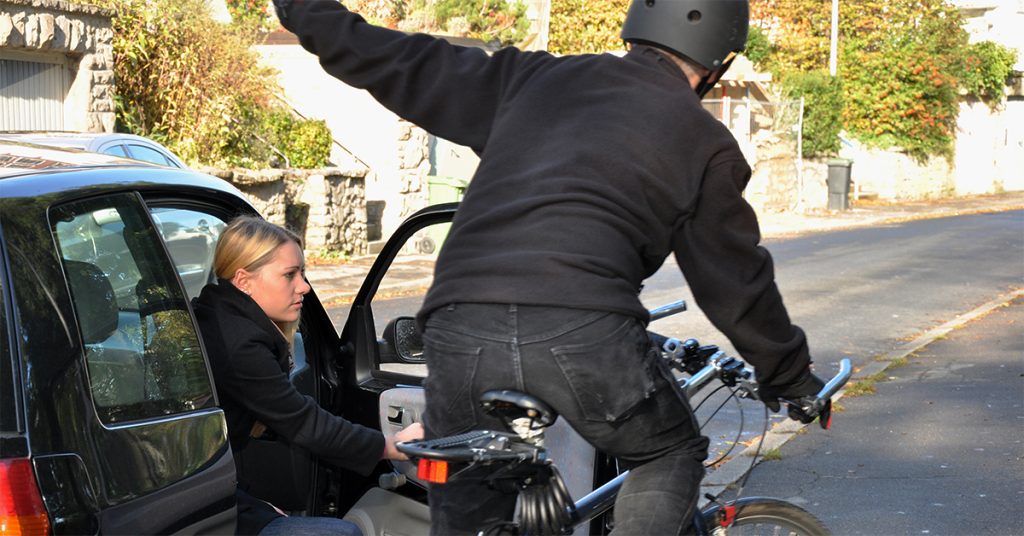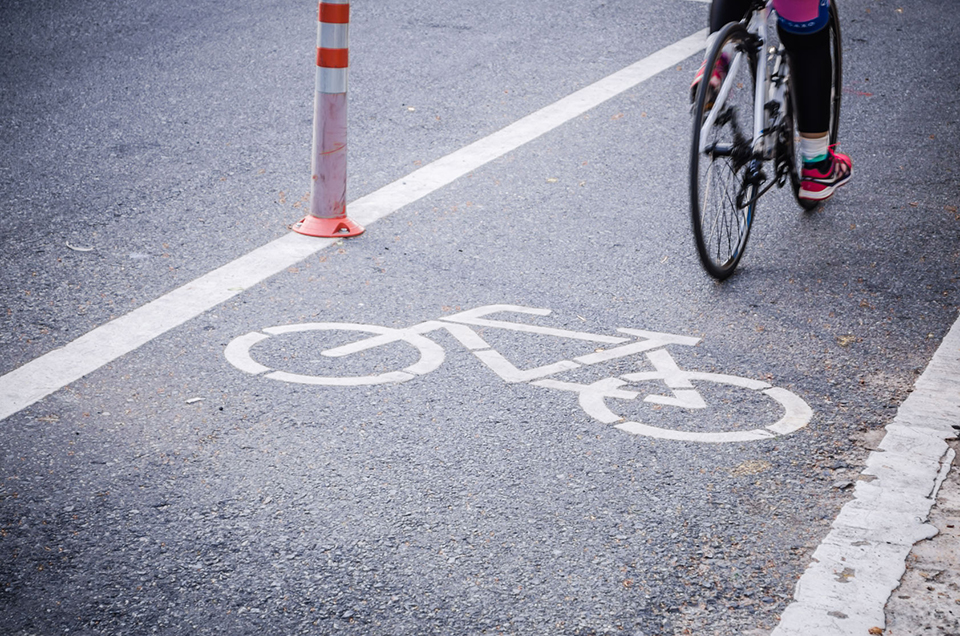Posts Tagged ‘Boston dooring accident lawyers’
Dooring Crashes Continue to Endanger Cyclists in Boston, Cambridge and Other Cities
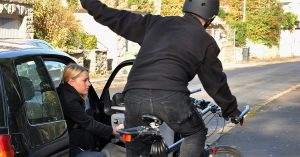 A recent New York Times article on dooring injuries shows the risks to cyclists continue, even after advocacy efforts in Boston and other cities.
A recent New York Times article on dooring injuries shows the risks to cyclists continue, even after advocacy efforts in Boston and other cities.
At Breakstone, White & Gluck, our attorneys represent cyclists who have been seriously injured in dooring accidents. While many dooring accidents happen in urban areas such as Boston, Cambridge and Somerville, dooring can happen in any community in Massachusetts. When drivers or passengers open doors without checking, cyclists can suffer devastating injuries, including broken bones, facial fractures and head injuries. Dooring crashes can be fatal.
Dooring crashes do not always make the news in Boston. But they are happening, more than any other type of bicycle accident. In fact, in November 2016, The Boston Globe reported cyclists faced a 225 percent higher risk for dooring than any other bicycle accident injury.
The Dutch Reach Moving Across the U.S.
The New York Times published, “The Dutch Reach: a No-Tech Way to Save Bicyclists’ Lives,” earlier this month. The Dutch Reach takes its name from the Netherlands, where there is a strong culture of safety for cyclists and drivers are taught to closely watch for bikes.
The New York Times interviewed Michael Charney, the Cambridge doctor who campaigned for greater use of the “Dutch Reach” method following the 2016 death of a cyclist in Inman Square. The 27-year-old woman was killed in a dooring crash. Charney’s campaign led the state of Massachusetts to add the “Dutch Reach” method to the state’s driver’s manual in 2017.
According to the article, Massachusetts and Illinois are now the only two states which have added “Dutch Reach” to the drivers’ manuals. Read the page from the Massachusetts driver’s manual.
Drivers can commit to drive safer and reduce the number of dooring crashes, according to those interviewed. Watch a video to learn the Dutch Reach method. Keep a colored ribbon or other reminder in your vehicle to help you check.
The Dutch have a great deal of education for drivers. Students actually start learning about road safety at age 10, then move to bikes before getting in a motor vehicle. Drivers typically spend about $2,700 for driver’s instruction, sitting for nearly 40 hours of instruction.
While you may not sign up for driver’s ed again. But remember that there is education online to help you. Groups such as AAA, AARP or the National Safety Council offer materials to help you avoid collisions. The League of American Bicyclists also offers materials and Bicycle Friendly Driver Training.
Here at Breakstone, White & Gluck, we also want to remind you to put down your cell phone and other distractions. With cyclists and other pedestrians around, it is not safe to reach for your cell phone as soon as you turn off the engine and just step outside without looking. Wait until you step onto the sidewalk and are out of the path of cyclists.
Injured? Free Legal Consultation for Cyclists: 800-379-1244
Breakstone, White & Gluck and our Boston personal injury lawyers specialize in bicycle accident cases. If you have been injured in a dooring accident, our experienced lawyers can represent your best interests, helping you obtain the medical treatment you need and investigating what happened to help ensure the driver is properly cited. For a free legal consultation, contact us at 800-379-1244 or 617-723-7676 or use our contact form.
New Protected Bike Lanes for Inman Square in Cambridge
Cyclists riding through Inman Square now have a safer ride home. The City of Cambridge has recently installed separated bicycle lanes on Cambridge Street, from Inman Square to Quincy Street. The lanes are clearly marked, with flex posts creating a barrier between cyclists and drivers.
These lanes should have many benefits. We hope one is to reduce dooring crashes, such as the one that killed Amanda Phillips in Inman Square in 2016. The 27-year-old Somerville resident was riding a bike and collided into a Jeep door which was left open. The impact pushed her into the travel lane, where she was hit and killed by a landscaping truck. The accident happened near Hampshire and Cambridge streets.
Dooring has been against the law in Massachusetts since 2009. M.G.L. c.90 § 14 states, “no person shall open a door on a motor vehicle unless it is reasonably safe to do so without interfering with the movement of other traffic, including bicyclists and pedestrians.”
For Cycling Safety: Dutch Reach Method Makes the Massachusetts Driver’s Manual
Cyclists may now ride safer near parked cars, after a recent update to the Massachusetts driver’s manual. On page 109, there is a new title, “The Danger of Open Doors to Bicyclists,” and instructions for the Dutch Reach method of exiting a car.
A common practice in the Netherlands, the Dutch Reach method calls on drivers to park and take three simple steps:
- Check your rear-view mirror.
- Check your side-view mirror.
- Open the door with your far hand, the hand farthest away from the door.
This last step forces drivers to turn their bodies, so they can see cyclists and pedestrians coming from both directions.
A Cambridge man campaigned for the change, which was announced by the Massachusetts Department of Transportation on May 30th. According to The Boston Globe, Michael Charney launched the website dutchreach.org following the death of Amanda Phillips, a 27-year-old barista at Somerville’s Diesel Café. Phillips was riding her bicycle in Inman Square in Cambridge when she struck the open door of a parked Jeep. As a result, Philips was pushed into the street and collided with a dump truck.
This is known as a dooring accident or a car-dooring crash. We have represented numerous cyclists in these accidents, which can cause very serious injuries and are more common than you may realize. According to the City of Boston, dooring accidents accounted for up to 13 percent of all bicycle crashes between 2009 and 2012.
Massachusetts is one of 40 states which have passed dooring laws, according to the League of American Cyclists. Under M.G.L. c. 90 § 14, “No person shall open a door on a motor vehicle unless it is reasonably safe to do so without interfering with the movement of other traffic, including bicyclists and pedestrians.”
Drivers can be fined $100 for each violation. But the greater penalty is drivers may have to pay compensation to injured cyclists. Read about a recent settlement we obtained for a cyclist injured in a dooring accident in Brookline.
Bay State Bike Week 2016: Have Fun and Be Safe
Welcome back cyclists! Bay State Bike Week is here and many of you are commuting to work for competition, attending commuter breakfasts, and participating in events to make this work week pass a little faster. The goals are to help protect the environment, reduce traffic congestion, get a little exercise, and have fun with other cyclists.
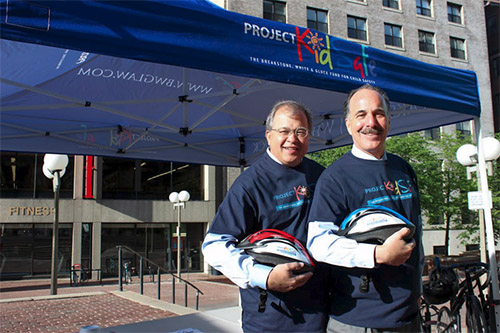 Attorney David White and Marc Breakstone on Boston City Hall Plaza with our Project KidSafe tent and Project KidSafe helmets during Bay State Bike Week 2015. The event was Bike Friday and it was organized by Boston Bikes.
Attorney David White and Marc Breakstone on Boston City Hall Plaza with our Project KidSafe tent and Project KidSafe helmets during Bay State Bike Week 2015. The event was Bike Friday and it was organized by Boston Bikes.
Breakstone, White & Gluck is pleased to participate as well. On Friday morning, we will join cyclists at the Bike to Work Day event on Boston City Hall Plaza. If you attend, please stop by our Project KidSafe tent and say hello to some of our lawyers! Boston Bikes is organizing the event.
Have fun and, as always, ride safely. Here are a few bicycling safety resources from our lawyers, MassBike, the Boston Cyclists Union, and other organizations:
Massachusetts Bicyclists’ Rights and Responsibilities
Our checklist of rights and responsibilities for bicyclists and motorists. Read more.
Wear a Bicycle Helmet
To help protect children and families, Breakstone, White & Gluck donates children’s bicycle helmets through our Project KidSafe campaign. Over four years, we have given away over 10,000 brand-new helmets to children who need one. Along the way, we often meet parents who want their children to be fitted for a helmet but do not have one of their own.
Every cyclist needs a bicycle helmet to protect themselves from a head injury in a crash. Bay State Bike Week is a good time check your existing helmet to see if it needs to be replaced. If it is worn or cracked, it is time for a new one! Learn how to properly fit a helmet. Here is a video with instruction:
“Shifting Gears: Bicyclists & Public Safety”
This 11-minute video was produced by MassBike, in partnership with the Massachusetts Department of Public Health and the Boston Police Department. The video was developed to provide police officers instruction on the laws for cyclists and motorists. But it is a good resource for any cyclist or driver.
Specific topics covered in the video include bicyclists’ right to use the road, dooring, safe passing, yielding to bicyclists on turns, parking in bike lanes, bicyclists’ compliance with rules of the road, hand signals, yielding to pedestrians, lights at night, wrong-way bicycling, and crash investigation.
What Every Massachusetts Bicyclist Needs to Know About Car Insurance
While we hope cyclists are never injured, it can make all the difference in the world to understand how your auto insurance policy works. Many cyclists do not realize this, but you can purchase extra coverage on your auto insurance to protect yourself if you are injured on a bicycle. This is important because there may be times when a driver does not have adequate insurance and you need to rely on your own coverage. Read more.
Facts About Cycling in Massachusetts
We answer questions about lights, hand signals, parking and more. Read more.
Trucks vs. Bikes
The Boston Cyclists Union has published this sheet to educate cyclists on the dangers they face when approached by some large trucks. Please read the sheet so you understand some of the risks.
According to Volpe National Transportation Systems Center, nearly half of all bicyclists and more than one-quarter of pedestrians killed in large truck crashes first impact the side of a truck. When a truck has high clearance, a cyclist can fall in the space between the front and rear wheels.
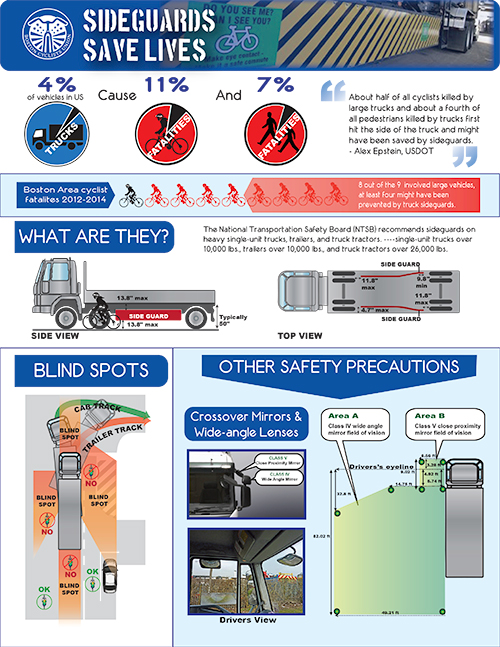
Mandated sideguard on large trucks have reduced cyclist deaths by 61 percent and serious injuries by 13 percent, according to a Transport for London study.
In October 2014, the City of Boston passed an ordinance, requiring truck sideguards, convex mirrors, blind spot awareness decals for city contracted trucks and tractor-trailers of a certain weight. Many trucks do not have to comply with the law, but this may change in the future. Legislation has been proposed to require truck sideguards statewide.
About Breakstone, White & Gluck
Breakstone, White & Gluck is a Boston personal injury law firm which is committed to the safety of all bicyclists in Massachusetts. We have over 100 years combined experience representing bicyclists injured by the negligence of others. If you, or a member of your family, has been injured in a bicycle incident, please feel free to contact us for a free legal consultation at 800-379-1244 or 617-723-7676 or use our contact form. Thank you and RIDE SAFE!
Safety for Pedestrians, Cyclists and Drivers
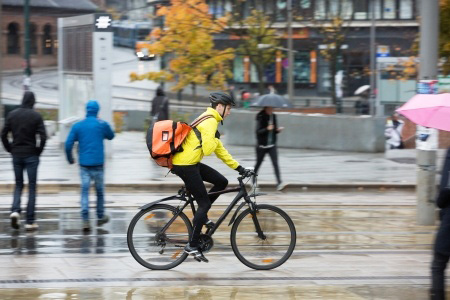 Safety for pedestrians and drivers was in the spotlight this winter, as Boston endured a record snow fall and everyone stood divided by the tallest of snowbanks. Now, as the snow starts to melt, cyclists are back out too and we want to take a moment to share a few safety reminders.
Safety for pedestrians and drivers was in the spotlight this winter, as Boston endured a record snow fall and everyone stood divided by the tallest of snowbanks. Now, as the snow starts to melt, cyclists are back out too and we want to take a moment to share a few safety reminders.
Safety was a priority this winter because Massachusetts saw many car accidents, even though state officials called multiple snow emergencies, and many schools closed, to keep the roads clear. We also saw at least two fatal pedestrian accidents. In Weymouth, a woman was hit and killed by a snow plow as she walked in the parking lot of her condominium complex. A 60-year-old employee at a Medford Whole Foods store also was killed, hit by a snow plow in the parking lot, leaving after his work shift.
Safety advocates made progress on protecting cyclists and pedestrians in 2014. This will serve as a strong foundation as we dig out from this harsh winter. In Boston, the city has implemented a truck safety ordinance, requiring that city-contracted trucks use sideguards and other protections aimed at protecting pedestrians and cyclists.
MassBike and other safety advocacy groups have also proposed new legislation which may get attention after this hard winter. If passed, the Bike Lane Protection Bill would make it illegal to block established bike lanes. The Vulnerable Road Users Bill would define pedestrians, cyclists, emergency personal and others as vulnerable road users and define a safe-passing distance for them.
Here are a few safety tips and facts to remember for pedestrians, cyclists and drivers:
Pedestrians
- Pedestrian accidents are too common. On average, in 2013, a pedestrian was killed every two hours and injured every eight minutes in traffic crashes, according to the National Highway Traffic Safety Administration (NHTSA).
- Walk on the sidewalks whenever possible. If a street only has sidewalks on one side, cross over.
- If you have to walk on the street, walk so you are facing oncoming motor vehicle traffic. Walk as close as you can to the curb to increase the space between you and traffic.
- Use crosswalks whenever they are available.
- Limit use of cell phones, iPods and music players.
- A common misperception is most pedestrian accidents happen at intersections. That is not true. Some 69 percent of pedestrian accidents occurred at non-intersections in 2013, according to the NHTSA.
- Some 10 percent of pedestrian accidents happened off the road, in areas such as parking lanes/zones, bicycle lanes, shoulders/roadsides, driveway access and similar areas.
- In the Spring of 2013, most pedestrian fatalities, 25 percent, occurred between 9 to 11:59 p.m., according to the NHTSA. Another 22 percent occurred between 6 to 8:59 p.m.
- If you walk at night, purchase a neon glow vest so you stand out to traffic. Even if you never wear it, it pays to be prepared.
Bicyclists
- Wear a bike helmet which meets the safety standard of the Consumer Product Safety Commission and properly fits.
- Cyclists follow different rules than pedestrians. Go with the flow of traffic, traveling in the same direction as cars, on the right side of the road. Up to two cyclists can ride in the middle of the traffic lane abreast if necessary to stay safe, but you should move back onto the side of the road single file when you can safely do so.
- State law prohibits biking on sidewalks in business districts. Not every city and town has a designated business district. But assume you are not allowed to ride on the sidewalk or ask the local police department for guidance.
- Cyclists must use hand signals to communicate to drivers, unless it would be unsafe to do so. You can view this video to learn the proper hand signals. Cyclists should also use a bell to let pedestrians know they are approaching.
- Watch out for dooring. This is when a car parks and the driver opens their door and hits you as you pass through. It is against the law, but it happens often.
- You are required to use a white headlight and red taillight or rear reflector if you ride anytime from a half hour after sunset until a half hour before sunrise.
- If you ride at night, consider purchasing a neon safety vest or clothing so you are more visible drivers..
- If you are involved in a bicycle accident, file a police report, even if you do not think you are seriously injured at first.
- Many drivers may not stop after cycling accidents. If you are hit and the driver does not stop, immediately contact police and file a police report.
Motor Vehicle Drivers
- Look for cyclists and pedestrians at every intersection and yield to them.
- Drivers must pass bicyclists at a safe distance. If you cannot, you must wait until it is safe to do so or change lanes.
- Obey all traffic laws and signals. Look for areas designated as school zones. Reduce your speed and take extra care on these roads.
- Do not park in bike lanes.
- Do not use your cell phone in the car. It is against the law in Massachusetts for drivers to text and drive, but the best practice is not to use it for telephone calls or other reasons either. It only takes a few seconds to cause a distracted driving car accident.
- A very dangerous practice is dooring. This is when a driver parks their car and opens the door without looking and hits an oncoming cyclist. It is against the law and violators can be fined. But drivers may also face a steeper penalty, a personal injury lawsuit, because cyclists can be seriously injured and the injuries can require months of recovery and hospital bills.
More Cycling Safety Resources
These are just a few rules of the road. To learn more, visit:
Shifting Gears: Bicyclists and Public Safety. Produced by MassBike, the Massachusetts Department of Public Health and the Boston Police Department.
Bike Safety in Massachusetts, Breakstone, White & Gluck.
What Every Massachusetts Bicyclist Needs to Know About Car Insurance, Breakstone, White & Gluck.
MassBike Video Answers Safety Questions for Cyclists and Drivers
MassBike recently released a new training video which answers many common questions about the laws for cyclists and drivers. The video is very well-done and offers some good re-enactments. We encourage you to watch it.
The 11-minute video is called Shifting Gears: Bicycles & Public Safety and was developed by MassBike in partnership with the Massachusetts Department of Public Health, the Boston Police Department and Boston Police Academy. The video was developed to train police officers on how to enforce the law.
The video explains M.G.L. c. 85, § 11B and M.G.L. c. 90, § 14, the laws regarding a bicyclist’s rights on the road and the obligations of motorists. A few topics covered: where a bicyclist is allowed to ride, the illegal practice of dooring a bicyclist, and how drivers must yield to cyclists. It also touches on sidewalk riding, red lights and stop signs (cyclists have to stop too) and other areas of the law.


